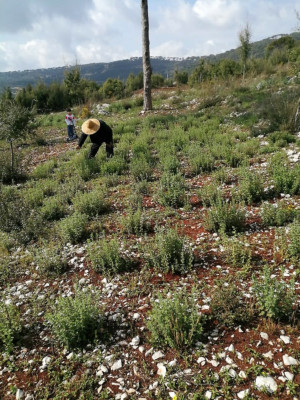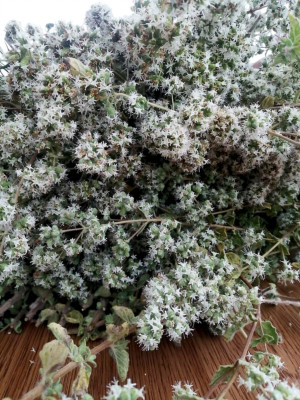Zaatar or thyme
 The word “Zaatar” (aka Zatar or Za’tar) refers to wild thyme herbs that grow in Lebanese and Middle Eastern wilderness. There are many kinds of Za’atar in the Levant. This Lebanese variety is a spicy, hearty, thyme-like plant with thin leaves and purple flowers. Its strong flavor makes it great for drying, pickling, or curing in olive oil. It is also used to refer to the herbal mix that will be featured in Zaatar recipe and which is found in every Lebanese kitchen. Zaatar is deeply rooted in Lebanese culture. It is a part of the culinary heritage passed down from generation to generation. It is considered a symbol of national identity and is often associated with Lebanese friendliness and hospitality.
The word “Zaatar” (aka Zatar or Za’tar) refers to wild thyme herbs that grow in Lebanese and Middle Eastern wilderness. There are many kinds of Za’atar in the Levant. This Lebanese variety is a spicy, hearty, thyme-like plant with thin leaves and purple flowers. Its strong flavor makes it great for drying, pickling, or curing in olive oil. It is also used to refer to the herbal mix that will be featured in Zaatar recipe and which is found in every Lebanese kitchen. Zaatar is deeply rooted in Lebanese culture. It is a part of the culinary heritage passed down from generation to generation. It is considered a symbol of national identity and is often associated with Lebanese friendliness and hospitality.
 Zaatar or thyme is the main ingredient in a spice mix. It is an emblematic element of Lebanon’s culinary and cultural heritage. It is a blend of aromatic herbs, mainly consisting of thyme (scientific name Origanum syriacum), sumac, toasted sesame and salt, although there are many local variations of this recipe.
Zaatar or thyme is the main ingredient in a spice mix. It is an emblematic element of Lebanon’s culinary and cultural heritage. It is a blend of aromatic herbs, mainly consisting of thyme (scientific name Origanum syriacum), sumac, toasted sesame and salt, although there are many local variations of this recipe.
Lebanese thyme is a wild herb found in almost all of the country’s mountainous areas. It is at the end of March that zaatar grows in Lebanon. For four months, all rural family members gather it in the wild. First, its leaves can be consumed directly, then its flowers which will be dried and mix with other zaatar ingredients. to be transformed into condiments. They then conserve it for the mune (winter provision) sell it to friends and family members.
Zaatar is used in several ways in Lebanon. Zaatar used for Manouche making. This is one of the most popular uses of zaatar in Lebanon. Zaatar is mixed with olive oil to create a thick paste, then spread onto thin bread dough and baked. This creates a delicious Lebanese pizza, often eaten for breakfast.
Zaatar is also used as a seasoning for a variety of dishes. It can be sprinkled on labneh, grilled vegetables, meats, salads or even used as a marinade.

